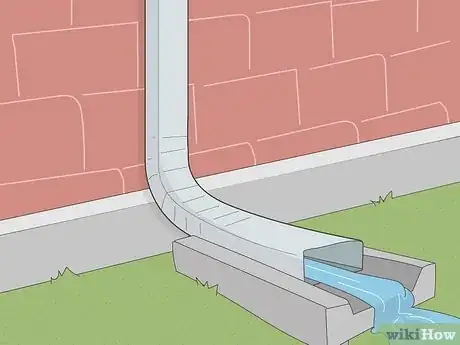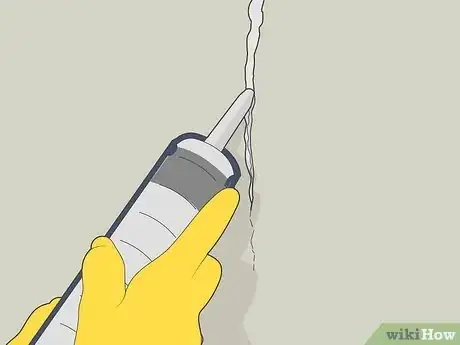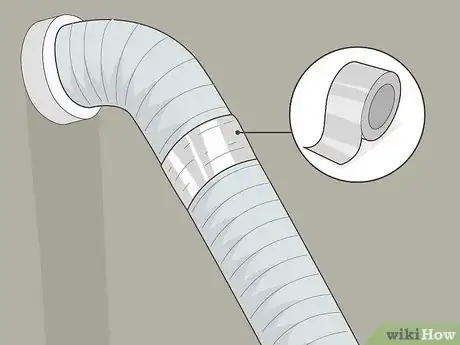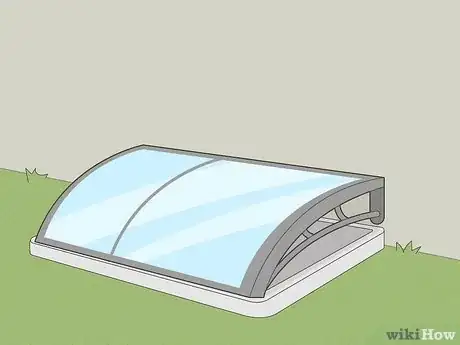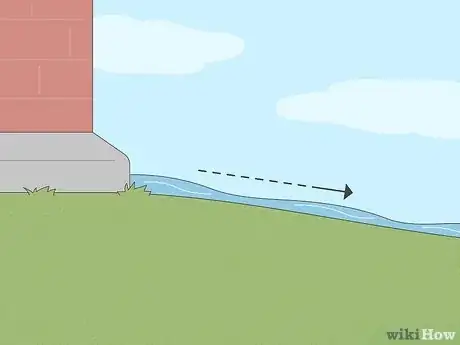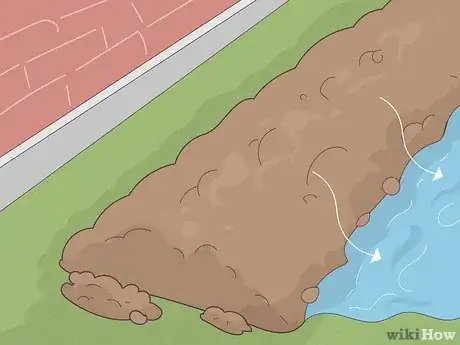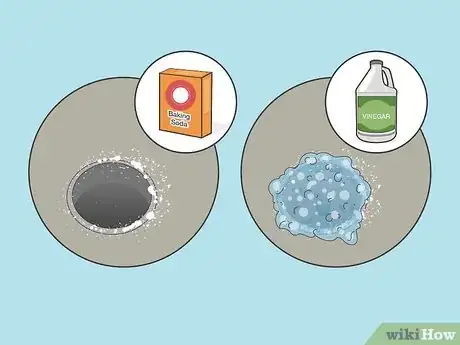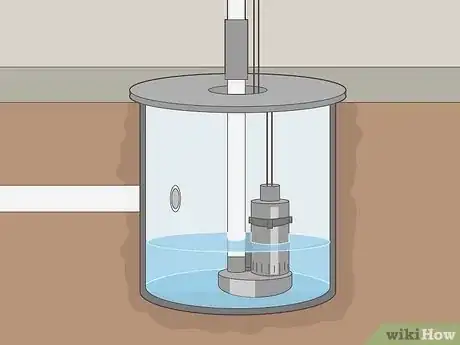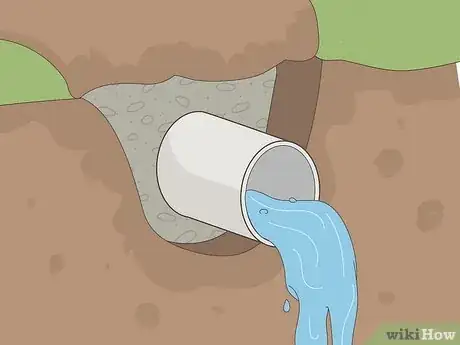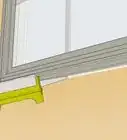This article was co-authored by Ryan Owsiany and by wikiHow staff writer, Glenn Carreau. Ryan Owsiany is a Drywall and Painting Specialist and the Owner of Patch and Paint Pros in Conshohocken, Pennsylvania. With over two decades of experience, Ryan specializes in interior and exterior house painting as well as drywall, plaster, and water damage repair. Ryan holds a BS in Industrial Engineering from Penn State University. Patch and Paint Pros only employ experienced, friendly painters that understand proper preparation is required to ensure client satisfaction on every painting project.
There are 11 references cited in this article, which can be found at the bottom of the page.
This article has been viewed 3,746 times.
Looking for a way to get the water out of your basement for good? No problem! We’ll walk you through all the different ways to stop water from seeping through basement walls and help you pick the best options for your house. Once you know where the water is coming from, finding the right fix is easy—and once that fix is in place, you’ll be enjoying your dry basement in no time.
Things You Should Know
- Attach gutter extensions and seal up wall cracks and dryer vents for a quick solution. Be sure to insulate leaky pipes, too.
- Apply masonry waterproofing paint to bare concrete walls, or install polycarbonate window well covers if water gets in through your windows.
- Install an interior drainage system with a sump pump or an exterior French drain to deal with heavier leaks that pool in your basement.
Steps
Attach gutter extensions.
-
Gutter extensions guide rainwater further away from your home. Check the downspouts (the vertical pipes attached to your gutters that deposit rainwater) outside your house. If they deposit water less than 5 feet (1.5 m) away from the house’s foundation, that’s likely how it’s getting through your basement walls. Install gutter extensions—diagonally-running pipes that attach to downspouts—to redirect the water.[1] X Research source
- Underground gutter extensions can save a little space in your yard. You can pay a landscaper to dig a trench and safely install the pipe for you.
Plug cracks in the wall with caulk.
-
Polyurethane caulk can block surface runoff and water from wet soil. Look for water leaking into your basement through cracks in the foundation, especially around plumbing pipes. If you find cracks, then your best bet for stopping the water is simply to fill them in with polyurethane caulk—or hydraulic cement, which works just as well.[2] X Research source
- Fixing foundation cracks is inexpensive and easy to do independently. Just clean off the wall before you apply the caulk, scrubbing away loose concrete and paint before filling in the cracks.
Seal dryer vents with foil tape.
-
Foil tape prevents humid air from getting in through leaky dryer vents. If water is getting in through your dryer vents, the easiest way to stop it is by wrapping the spots where the vent leaks with foil tape. The tape is crack-resistant and resistant to heat, so it’ll last a long time and keep water out of your basement indefinitely.[3] X Research source
- Don’t use ordinary duct tape on your dryer vent. Its adhesive isn’t meant to withstand high temperatures from the dryer, and the tape could even catch fire in the long run.
Insulate your pipes.
-
Insulate cold water pipes to prevent condensation from dripping. When pipes get cold, they attract moisture from the warmer air around them, causing condensation that drips from the pipe’s exterior. If you notice water leaking from your cold water pipes, you can fix it by covering each leaky pipe with foam pipe insulation. That’ll stop water from getting into your basement![4] X Research source
Coat the walls in masonry waterproofing paint.
-
Waterproofing paint creates a protective layer around your interior walls. If water leaks directly through your walls, add a coat of masonry waterproofing paint to keep the water out. Clean off the walls first—this type of paint only works when applied to bare concrete or masonry walls. Remove loose material with a wire brush and white powdery residue with masonry cleaner before applying the paint with a paint roller.[5] X Research source
- Don’t spread the waterproofing too thin! Your goal is to fill in all the cracks and pinholes to make a cohesive layer of protection.
- Wait for the first coat of waterproofing paint to dry and then add a second one to ensure your basement walls are thoroughly covered.
Install fitted window well covers.
-
Well covers prevent water from dripping into basement windows. Are there leaves and debris in your basement’s window wells? They can build up and clog window wells, which fill with water that leaks into your basement. If you notice water coming in through the basement windows, attach solid polycarbonate window well covers on each one. Be sure to measure your wells and get a cover that will fit them.[6] X Research source
- If you don’t have window wells, installing them can prevent water and soil from getting inside any ground-level basement windows.
Fix the grading to slope away from your house.
-
Sloped ground ensures that water drains away from the house. If water still drips into your basement from high up on the wall, it likely means that surface water isn’t draining away from the foundation properly. To fix that, increase the slope of the landscape all around your house, so it slants about 6 inches (15 cm) down over the first 10 feet (3.0 m) of ground.[7] X Research source
- “Grading” is the process of adjusting the slope and soil elevation around your house to direct water flow as it drains through the soil.
- You can build the slope easily with a shovel and dirt or pay a landscaper to address the problem for you.
- A little landscaping can go a long way to prevent water from seeping down your foundation walls.
Make a berm or swale around the foundation.
-
Berms and swales alter the landscape to keep water away from the house. If water leaks high up on your basement walls, create a berm (a raised barrier of soil that improves drainage) or a swale (a broad, shallow ditch that catches water runoff) around your house. Build a berm if you have a smaller house and area to cover, and dig a swale if you have a lot of land to reshape.[8] X Research source
- When heavy rain falls, swales (the shallow ditch) direct it down into the soil rather than towards your house. Berms (the raised barrier) are like shields, stopping the water flow to your house and diverting it into the soil.
- Berms are tougher for big projects because you’d have to truck in a lot of extra soil to make them, whereas you can make a swale by digging.
- You can also hire a landscaping contractor to build a berm, usually for a few hundred dollars.
Unclog your footing drains.
-
Water leaks if footing drains (underground drainage pipes) get clogged. To unclog a footing drain, unscrew the drain grate with a screwdriver. Pour 1 1⁄3 gallons (5.0 L) of hot water down the drain and let it sit for 15 minutes. Then, coat the pipe with 1 lb (453 grams) of baking soda. Add 1 gallon (3.8 L) of vinegar and let it sit for 10 minutes before flushing out the pipe with more hot water.[9] X Research source
- You can tell that you have a footing drain clog if water leaks into your basement at the seam where the wall meets the floor.
- If you’re unsure whether you have a footing drain, search the perimeter of your basement for a circular metal drain set into the floor. That’s a footing drain (also known as a fountain drain)!
Install a sump pump.
-
Sump pumps can drain water from the basement and eject it outside. For a more permanent fix to your basement problems, you could install a full sump pump drainage system to remove water continually as it gets into the basement. You’ll need to remove part of the floor and install a pipe draining water to the sump pump, which then shoots water back outside.[10] X Research source
- The pump and materials can be expensive. You can install it yourself for less, but paying a contractor can cost a few thousand dollars.
- Though it’s expensive, a sump pump drainage system is worth the trouble because it’ll keep your basement from flooding!
Set up a French drain.
-
French drains stop water in the soil outside from leaking into the house. Are there wet spots on your lawn where water pools and leaks into the basement from high on the walls? Install a French drain (also called a curtain drain) to stop it. Lay a perforated drain pipe into a 24-inch (61 cm)-deep trench lined with landscaping fabric and gravel. The French drain will carry water away from your basement.[11] X Research source
- If you’d rather not tear up a finished basement floor, a French drain might be your best bet! Plus, interior drainage systems (like sump pumps) remove water but don’t prevent it from getting in.
- Like sump pumps, French drains can be expensive to install because it involves excavating around the house, but it pays off in the end by protecting the house’s foundation long-term.
References
- ↑ https://www.lcbp.org/get-involved/what-you-can-do/stormwater/how-to-redirect-a-downspout/
- ↑ https://www.thisoldhouse.com/basements/21015315/drying-out-a-wet-basement
- ↑ https://bestairducts.com/can-you-use-duct-tape-on-dryer-vents/
- ↑ https://www.greenbuildingadvisor.com/article/should-i-insulate-my-cold-water-pipes
- ↑ https://garagetransformed.com/waterproof-your-garage/
- ↑ https://tandcinspection.com/window-well-covers-what-to-know-and-how-to-install/
- ↑ https://www.mmsd.com/what-you-can-do/managing-water-on-your-property/proper-grading-around-your-home
- ↑ https://santacruzpermaculture.com/2019/08/berms-swales/
- ↑ https://youtu.be/cZGGUKBaT0E?t=27
About This Article

